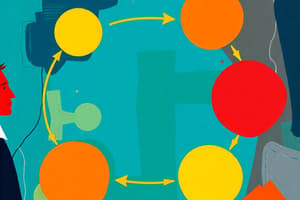Podcast
Questions and Answers
Which equation represents the relationship between mean arterial pressure (MAP), cardiac output, and total peripheral resistance?
Which equation represents the relationship between mean arterial pressure (MAP), cardiac output, and total peripheral resistance?
- MAP = cardiac output / total peripheral resistance
- MAP = cardiac output - total peripheral resistance
- MAP = cardiac output + total peripheral resistance
- MAP = cardiac output × total peripheral resistance (correct)
What is the formula to calculate cardiac output?
What is the formula to calculate cardiac output?
- Cardiac output = heart rate / stroke volume
- Cardiac output = heart rate - stroke volume
- Cardiac output = heart rate × stroke volume (correct)
- Cardiac output = heart rate + stroke volume
Which of the following statements accurately describes stroke volume (SV)?
Which of the following statements accurately describes stroke volume (SV)?
- It is the volume of blood pumped out of each ventricle per heartbeat. (correct)
- It is the volume of blood found in each atrium at the end of diastole.
- It is the volume of blood left in each ventricle at the end of systole.
- It is the volume of blood that fills the atria during relaxation.
What is the formula to calculate stroke volume (SV)?
What is the formula to calculate stroke volume (SV)?
When does the end systolic volume (ESV) occur?
When does the end systolic volume (ESV) occur?
What does a decrease in ejection fraction indicate?
What does a decrease in ejection fraction indicate?
What is ejection fraction?
What is ejection fraction?
What happens during diastolic heart failure?
What happens during diastolic heart failure?
Which of the following factors promotes venous return to the heart?
Which of the following factors promotes venous return to the heart?
What effect does inhalation have on venous return?
What effect does inhalation have on venous return?
How does gravity affect venous return?
How does gravity affect venous return?
Which of the following represents the relationship described by Starling's law of the heart?
Which of the following represents the relationship described by Starling's law of the heart?
What is the role of sarcomere stretching in relation to Starling's law of the heart?
What is the role of sarcomere stretching in relation to Starling's law of the heart?
What is the effect of increasing end-diastolic volume (EDV) on the force of contraction in the heart?
What is the effect of increasing end-diastolic volume (EDV) on the force of contraction in the heart?
What is the relationship between venous return (VR) and end-diastolic volume (EDV)?
What is the relationship between venous return (VR) and end-diastolic volume (EDV)?
What effect does an increase in stroke volume (SV) have on cardiac output (CO)?
What effect does an increase in stroke volume (SV) have on cardiac output (CO)?
What is the role of calcium in excitation-contraction coupling in cardiomyocytes?
What is the role of calcium in excitation-contraction coupling in cardiomyocytes?
What is the role of calcium in excitation-contraction coupling in cardiomyocytes?
What is the role of calcium in excitation-contraction coupling in cardiomyocytes?
What effect does stretching the heart muscles have on the force of contraction?
What effect does stretching the heart muscles have on the force of contraction?
What is the significance of Starling's law in relation to contraction force?
What is the significance of Starling's law in relation to contraction force?
Which of the following events occurs after calcium enters during excitation-contraction coupling in cardiomyocytes?
Which of the following events occurs after calcium enters during excitation-contraction coupling in cardiomyocytes?
Which of the following mechanisms is responsible for positive inotropy observed after an increase in heart rate?
Which of the following mechanisms is responsible for positive inotropy observed after an increase in heart rate?
What is the role of the Na+/K+-ATPase in maintaining the Na+ gradient in cardiomyocytes?
What is the role of the Na+/K+-ATPase in maintaining the Na+ gradient in cardiomyocytes?
What effect does the Anrep effect have on myocardial contractility?
What effect does the Anrep effect have on myocardial contractility?
What is the main function of SERCA in cardiomyocytes?
What is the main function of SERCA in cardiomyocytes?
What is the role of troponin in the mechanism of inotropy in cardiomyocytes?
What is the role of troponin in the mechanism of inotropy in cardiomyocytes?
Which of the following statements accurately describes the Bowditch effect?
Which of the following statements accurately describes the Bowditch effect?
What happens to starlings law when heart rate increases?
What happens to starlings law when heart rate increases?
What happens to contractility in a failing heart when heart rate increases?
What happens to contractility in a failing heart when heart rate increases?
Which of the following is the main mechanism responsible for the Anrep effect in cardiomyocytes?
Which of the following is the main mechanism responsible for the Anrep effect in cardiomyocytes?
What is the role of the Na+/K+-ATPase in the Anrep effect?
What is the role of the Na+/K+-ATPase in the Anrep effect?
How does the Anrep effect affect the force of myocardial contraction?
How does the Anrep effect affect the force of myocardial contraction?
What is the primary focus of Starling's law of the heart?
What is the primary focus of Starling's law of the heart?
What is the primary focus of the Anrep effect?
What is the primary focus of the Anrep effect?
Which of the following equations represents the relationship between cardiac output (CO), stroke volume (SV), and heart rate (HR)?
Which of the following equations represents the relationship between cardiac output (CO), stroke volume (SV), and heart rate (HR)?
Flashcards are hidden until you start studying




